- Home›
- Healthy Living›
- 7 Yoga Poses You Can Try For Muscle Growth
7 Yoga Poses You Can Try For Muscle Growth
By: Priyanka Maheshwari Mon, 08 July 2024 11:16:48
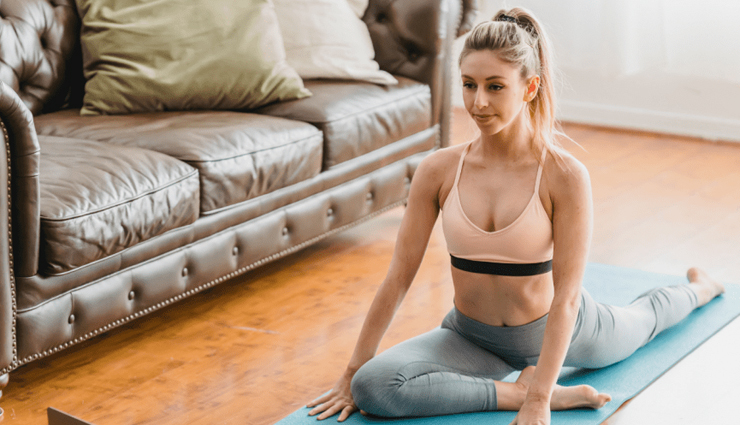
When we talk about building muscle, heavy weights and intense resistance training often come to mind. However, muscle growth—or muscle hypertrophy—is more versatile than that. It’s the process where muscle fibers increase in size and strength, responding to challenges and stresses, not just from weightlifting but from various forms of exercise, including yoga.
Muscle growth happens through a balance of muscle protein synthesis (the creation of new muscle proteins) and muscle protein breakdown (the degradation of muscle proteins). For effective muscle growth, the rate of synthesis needs to surpass breakdown. Resistance training usually triggers this balance by activating key physiological responses, including the release of anabolic hormones like testosterone and growth hormone, which play a significant role in stimulating muscle protein synthesis and enhancing nutrient delivery.
Proper nutrition is essential in this process. Adequate protein intake provides amino acids for muscle repair and growth, while carbohydrates and healthy fats supply the energy required for intense physical activity. Equally important is rest and recovery, during which muscle fibers repair and grow stronger.
Now, you might be surprised to learn that yoga, with its focus on body weight, balance, and controlled movements, can also contribute significantly to muscle hypertrophy. Yoga challenges muscles in unique ways, building strength, improving flexibility, and reducing injury risk—all essential elements of a balanced muscle-building regimen. Whether you’re a fitness enthusiast or new to exercising, integrating yoga can complement traditional workouts and help you achieve a well-rounded, strong, and sculpted physique.
Here are 7 yoga poses that can effectively enhance muscle growth and strength. Explore how these poses can become a powerful part of your fitness routine for optimal muscle development.
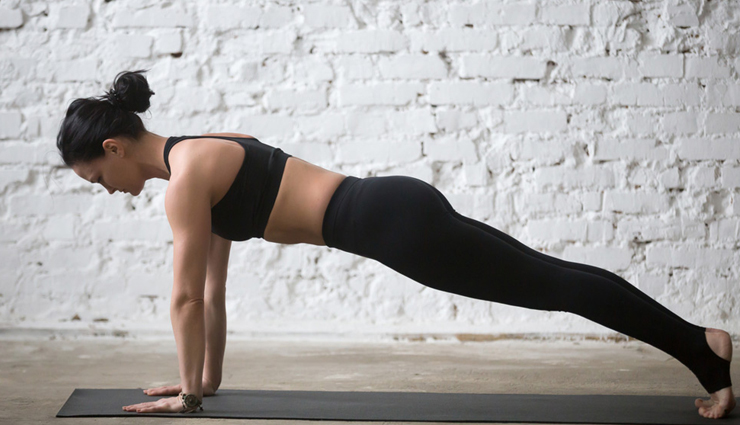
# Phalakasana
Phalakasana, also known as Plank Pose, is a foundational yoga pose that targets the core, shoulders, arms, and legs. Here's a step-by-step guide on how to perform Phalakasana:
- Start by coming into a tabletop position on your hands and knees, with your wrists directly under your shoulders and knees under your hips.
- Extend one leg back at a time, keeping your toes tucked under and legs straight. Engage your abdominal muscles to maintain a straight line from your head to your heels.
- Press firmly through your palms, spreading your fingers wide and pressing into all parts of your hands. This will help distribute the weight evenly and activate your arm muscles.
- Keep your neck in a neutral position by gazing slightly forward or down to maintain alignment with your spine.
- Engage your core by drawing your navel toward your spine, which will help stabilize your torso.
- Press through your heels and the balls of your feet, activating your leg muscles. Keep your legs straight and engaged throughout the pose.
- Maintain a steady and even breath while holding the pose. Aim to hold Phalakasana for 30 seconds to 1 minute, gradually increasing the duration as you build strength.
- To release the pose, gently lower your knees back down to the mat and rest in Child's Pose or another comfortable resting position.
Tips:
- Avoid sagging or lifting your hips too high. Aim for a straight line from your head to your heels.
- If you're a beginner or need extra support, you can modify Phalakasana by lowering your knees to the mat, keeping the upper body alignment and engagement.
- Pay attention to your form and listen to your body. If you feel any discomfort or strain, gently come out of the pose and make necessary adjustments.
Practicing Phalakasana regularly can help strengthen your core, improve posture, and enhance overall body stability.
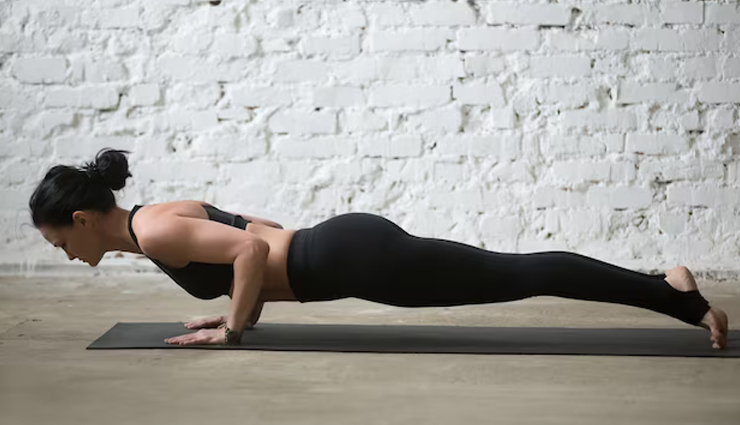
# Chaturanga Dandasana
Chaturanga Dandasana, also known as Four-Limbed Staff Pose, is a challenging yoga pose that strengthens the arms, shoulders, and core. It is commonly performed as part of the Sun Salutation sequence. Here's a step-by-step guide on how to do Chaturanga Dandasana:
- Start in Plank Pose (Phalakasana), with your hands directly under your shoulders and your body in a straight line from head to heels. Engage your core and leg muscles.
- Shift your weight forward, coming onto the balls of your feet. Keep your elbows close to your sides as you lower your body down. The movement is similar to a push-up, but with your elbows tucked in instead of flaring out.
- As you lower down, maintain a straight line from your head to your heels. Keep your core engaged and your gaze slightly forward to maintain proper alignment.
- Stop when your elbows are at a 90-degree angle, hovering just above the ground. Your upper arms should be parallel to the floor.
- Keep your shoulders away from your ears, drawing your shoulder blades back and down. This will help to stabilize the pose and engage your upper body muscles.
- If you can, hold the pose for a breath or two, maintaining stability and engagement throughout your entire body.
- To release the pose, either press back up to Plank Pose or lower your knees to the ground, and then move into a resting position like Child's Pose.
Tips:
- If you're new to Chaturanga Dandasana or still building strength, you can modify the pose by lowering your knees to the ground while keeping the alignment and engagement in your upper body.
- Avoid letting your lower back sag or your hips droop. Aim for a straight line from your head to your knees or heels, depending on the modification you choose.
Practicing Chaturanga Dandasana with proper form and gradually increasing your strength will help build upper body and core strength, improve stability, and enhance your overall yoga practice. It's essential to listen to your body and work within your capabilities to avoid strain or injury.
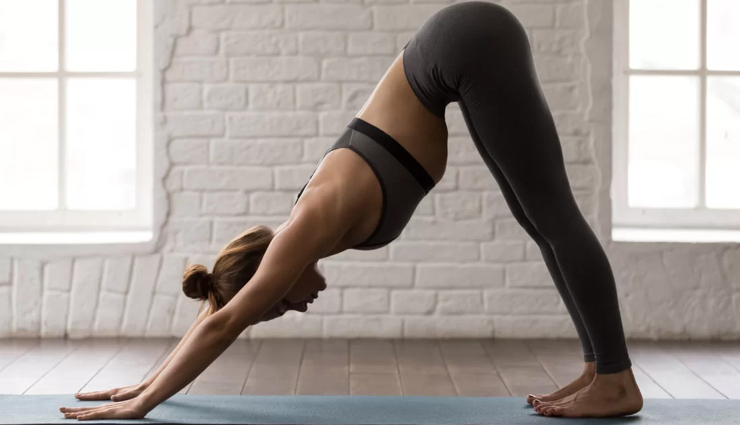
# Adho Mukha Svanasana
Adho Mukha Svanasana, also known as Downward-Facing Dog Pose, is a popular yoga pose that stretches and strengthens the entire body while promoting relaxation. Here's a step-by-step guide on how to do Adho Mukha Svanasana:
- Start on your hands and knees in a tabletop position, with your wrists under your shoulders and your knees under your hips.
- Spread your fingers wide and press firmly through your palms, grounding your hands into the mat. Your middle fingers should be pointing forward or slightly turned out.
- Tuck your toes under and exhale as you lift your knees off the ground, straightening your legs. Initially, you may keep a slight bend in your knees if needed.
- As you lift your hips, begin to straighten your arms and legs, creating an inverted V-shape with your body. Keep your hands shoulder-width apart or slightly wider.
- Press through your palms and actively engage your arm muscles. Allow your shoulder blades to draw down your back, creating space in your upper body.
- Relax your head and neck, allowing them to hang naturally between your arms. Your gaze can be directed toward your feet or slightly back toward your legs.
- Actively press your heels toward the ground. If your hamstrings are tight, it's okay to have a slight bend in your knees. The goal is to lengthen your spine and create a stretch through the back of your legs.
- Maintain an even breath as you hold the pose, allowing for a sense of grounding and relaxation. Beginners can start by holding the pose for 30 seconds to 1 minute, gradually increasing the duration with practice.
- To release the pose, exhale and lower your knees back to the mat, returning to a tabletop position or moving into a resting posture like Child's Pose.
Tips:
- Focus on creating length in your spine by reaching your hips up and back while grounding through your hands and heels.
- Keep your core engaged to support your lower back and maintain stability throughout the pose.
- If you experience wrist discomfort, try placing your hands slightly wider or using yoga blocks to elevate your hands.
Practicing Adho Mukha Svanasana regularly can help improve flexibility, strengthen the arms and shoulders, lengthen the spine, and provide a rejuvenating stretch for the whole body. As with any yoga pose, listen to your body, modify as needed, and honor your limits to prevent strain or injury.
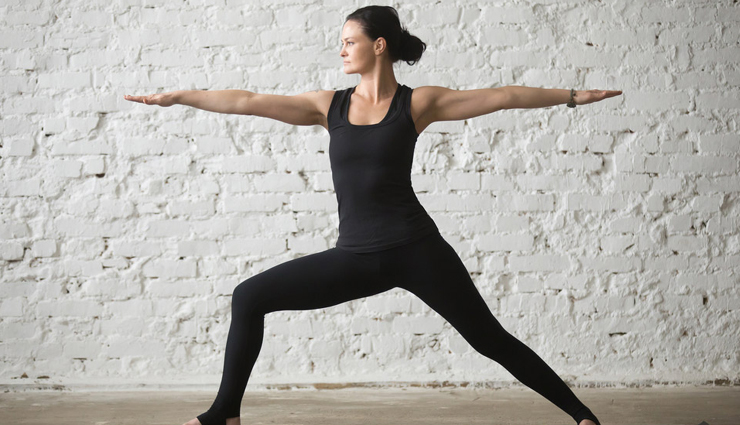
# Virabhadrasana II with Dumbbells
Virabhadrasana II, also known as Warrior II pose, is a powerful standing yoga pose that strengthens the legs, opens the hips, and improves stability. Here's how you can incorporate dumbbells into the practice of Virabhadrasana II:
- Begin by standing at the top of your mat with your feet together and your dumbbells by your sides. Take a moment to ground yourself and find a stable stance.
- Step your feet wide apart, around 3 to 4 feet, depending on your comfort and flexibility. Your feet should be parallel to each other, or you can slightly turn your back foot inwards.
- Raise your arms to shoulder height, holding a dumbbell in each hand, with your palms facing down. Keep your arms strong and engaged.
- As you exhale, bend your front knee, ensuring that it aligns directly over your ankle. Your thigh should be parallel to the ground, forming a 90-degree angle.
- Keep your back leg straight and strong, pressing into the outer edge of your back foot. Your back foot should be at a slight angle to the front of the mat.
- Open your hips and square your torso toward the side of the mat. Engage your core and lengthen through your spine, maintaining an upright posture.
- Gaze over your front hand, focusing your gaze beyond your fingertips. Keep your neck relaxed and your facial muscles soft.
- Hold the pose for several breaths, feeling the strength and stability in your legs and the activation of your core and upper body.
- To release the pose, straighten your front leg, lower your arms, and bring your feet back together at the top of the mat.
Tips:
- Choose dumbbells that provide a challenging but manageable weight for your fitness level. Start with lighter weights if you're new to incorporating dumbbells into yoga poses.
- Keep your movements smooth and controlled, avoiding any sudden or jerky motions.
- Focus on the alignment of your front knee, ensuring it doesn't extend past your ankle and stays in line with your toes.
- Engage your core throughout the pose to maintain stability and support your lower back.
Incorporating dumbbells into Virabhadrasana II adds resistance and increases the intensity of the pose, challenging your muscles further. Remember to listen to your body, make adjustments as needed, and choose weights that allow you to maintain proper form throughout the practice.
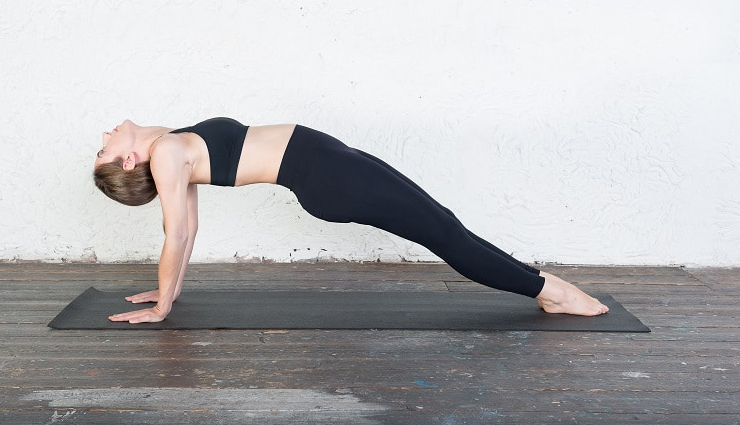
# Purvottanasana
Purvottanasana, also known as Upward Plank Pose, is a challenging yoga pose that strengthens the arms, shoulders, core, and legs while opening the chest and stretching the front of the body. Here's a step-by-step guide on how to do Purvottanasana:
- Begin by sitting on your mat with your legs extended in front of you. Place your hands several inches behind your hips, with your fingers pointing forward and slightly turned outward.
- Press through your palms and lift your hips off the mat, coming into a reverse tabletop position. Ensure your wrists are directly under your shoulders and your fingers are pointing toward your feet.
- As you lift your hips, engage your core and legs to create a straight line from your head to your heels. Your knees should be straight but not locked.
- Keep your shoulder blades drawn together and down your back, opening your chest and allowing the front of your body to expand.
- Gently drop your head back, lengthening through your neck. If this is uncomfortable for your neck, you can keep your head in a neutral position or slightly tuck your chin.
- Hold the pose for several breaths, feeling the engagement in your arms, shoulders, core, and legs. Maintain a steady and even breath throughout the pose.
- To release the pose, exhale and slowly lower your hips back down to the mat.
Tips:
- Be mindful of your wrist health. If you experience any discomfort or strain in your wrists, you can modify the pose by using yoga blocks or placing your hands slightly wider.
- Engage your glutes and leg muscles to support your hips and maintain stability in the pose.
- If you're new to Purvottanasana, start by lifting your hips just a few inches off the mat and gradually work your way up to a higher lift over time.
- Avoid letting your shoulders scrunch up toward your ears. Instead, actively draw your shoulder blades down your back to maintain a spacious and open chest.
Practicing Purvottanasana regularly can help build upper body strength, improve posture, and increase flexibility in the chest and shoulders. As with any yoga pose, listen to your body, honor your limitations, and adjust the pose as needed to avoid strain or injury.
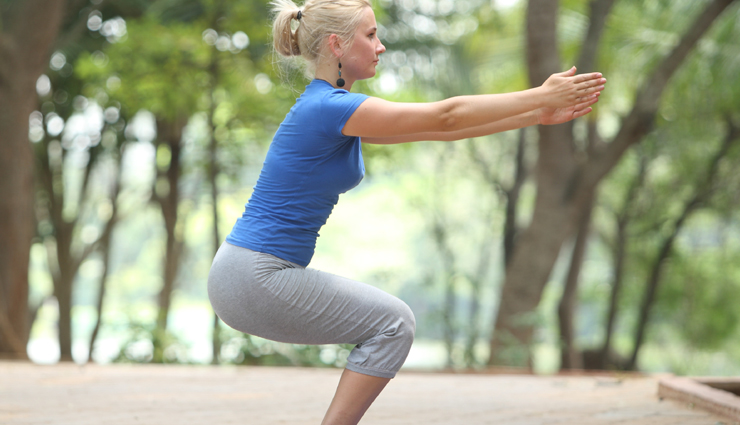
# Utkatasana
Utkatasana, also known as Chair Pose or Fierce Pose, is a standing yoga pose that strengthens the legs, engages the core, and promotes stability. Here's a step-by-step guide on how to do Utkatasana:
- Begin by standing tall at the top of your mat with your feet together and your arms by your sides. Take a moment to ground yourself and find a stable stance.
- Inhale and raise your arms straight up alongside your ears, palms facing each other or slightly touching. Keep your shoulders relaxed and away from your ears.
- Exhale and bend your knees as if you're sitting back into an imaginary chair. Keep your thighs parallel to the ground, or if possible, aim for your thighs to be slightly lower than parallel.
- Engage your core by drawing your navel in toward your spine. This will help stabilize your torso and maintain balance.
- Shift your weight back into your heels, ensuring that your knees are directly above your ankles. This helps to activate your leg muscles and promotes proper alignment.
- Lengthen your spine by lifting through the crown of your head. Keep your chest lifted and your gaze forward, avoiding rounding your back or hunching your shoulders.
- Stay in Utkatasana for several breaths, breathing deeply and steadily. As you hold the pose, feel the strength and engagement in your legs and core.
- To release the pose, exhale and straighten your legs, lowering your arms back down to your sides.
Tips:
- If you have tightness in your calves or hamstrings, you can modify the pose by coming up onto the balls of your feet slightly or by keeping a slight bend in your knees.
- Make sure to distribute your weight evenly between both feet, avoiding leaning too far forward or backward.
- If you experience any discomfort in your lower back, try engaging your core more and focusing on maintaining a neutral spine.
- Remember to breathe deeply and avoid holding your breath during the pose. The breath can help you find stability and relaxation.
Practicing Utkatasana regularly can help strengthen the legs, improve balance, and build stability in the core. As with any yoga pose, listen to your body, make necessary adjustments, and work within your comfort and capability to avoid strain or injury.
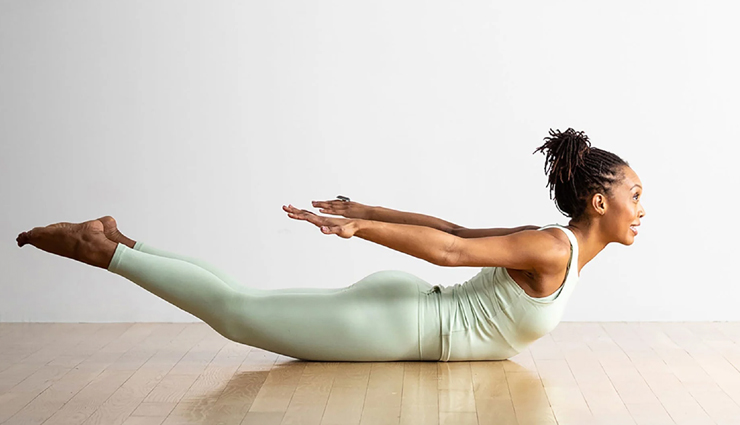
# Salabhasana
Salabhasana, also known as Locust Pose, is a prone yoga pose that strengthens the back, glutes, and legs while promoting improved posture. Here's a step-by-step guide on how to do Salabhasana:
- Start by lying flat on your mat with your forehead resting on the floor. Keep your legs together and arms by your sides, palms facing down.
- Engage your core muscles and lengthen your tailbone toward your heels to create a stable foundation.
- As you inhale, lift your head, chest, and arms off the mat. Keep your gaze forward and your neck aligned with your spine. This is often referred to as Half Locust Pose (Ardha Salabhasana).
- If you feel comfortable in Half Locust Pose, you can progress to Full Locust Pose (Purna Salabhasana) by continuing the movement. As you exhale, lift your legs off the mat, engaging your glutes and hamstrings.
- Extend your legs straight back, keeping them together and engaged. Reach through your toes and press out through your heels.
- Avoid tensing your shoulders or scrunching your neck. Keep your shoulder blades drawing toward each other and down your back to open your chest.
- Hold the pose for several breaths, maintaining the lift and engagement in your entire body. Feel the strength and lengthening in your back muscles.
- To release the pose, exhale and lower your head, chest, and legs back down to the mat. Rest in a comfortable position, such as Child's Pose, to relax and recover.
Tips:
- If you have tightness in your lower back, you can modify the pose by lifting only one leg at a time or by keeping your legs closer to the ground.
- Avoid straining your neck. Keep your gaze forward and your neck aligned with your spine.
- Focus on the engagement of your glutes and legs to lift your legs and maintain stability in the pose.
- Maintain a steady and controlled breath throughout the pose to help you find balance and relaxation.
Practicing Salabhasana regularly can help strengthen your back muscles, improve posture, and enhance overall body strength. As with any yoga pose, listen to your body, modify as needed, and work within your comfort and capability to avoid strain or injury.





